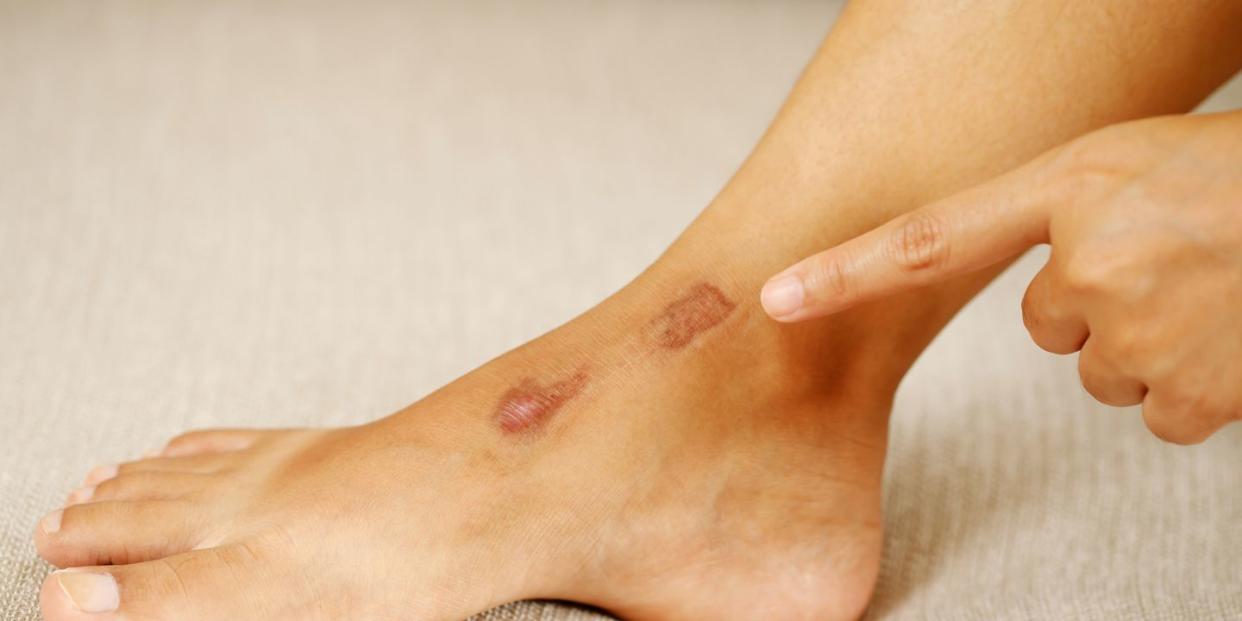9 Ways to Get Rid of Keloids, According to Experts

If you’ve ever discovered a raised scar that extends past your original wound (whether it be a surgical scar, piercing, or run-of-the-mill cut), you might have a keloid. This abnormal-looking rapid growth of tissue can be unsightly, and sometimes even uncomfortable. Thankfully, we’re sharing how to get rid of keloids so you don’t have to relive the reason for the overgrown scar time and time again. Ahead, experts share home remedies, medical treatments, and prevention methods for the type of scar.
What is a keloid?
A keloid is an abnormal proliferation of scar tissue where the scar tissue extends beyond the original margins of the scar, according to Mamina Turegano, M.D., triple board-certified dermatologist, internist, dermatopathologist, and co-founder of Skintap.com. “There appears to be a genetic predisposition for developing keloids,” she explains, adding that they are more common among people of African, Asian, or Hispanic descent. “We see them occur more commonly on the upper torso (chest, shoulders, upper back) and ears. But they can occur anywhere on the body.”
How do keloids form?
Dr. Turegano says keloids can form after an injury, but they can also occur in a surgical scar, ear piercing, tattoo, or in skin conditions like acne or chicken pox.
There are a couple of different ways you can either reduce their appearance or smooth their texture – depending on where they’re located and their size—including home remedies and pharmaceutical solutions that can help you get rid of keloids altogether.
Keloid home remedies
There are plenty of over-the-counter methods that can help reduce the size and appearance of your scars. “Home remedies can include silicone sheets or gels or using compression or pressure earrings, dressing, or garment,” explains Dr. Turegano.
Silicone sheets and gels
Dr. Turegano says silicone sheets and gels, which you can buy at your pharmacy and certain retail outlets, can reduce the size, color, and texture of keloids. These treatments work by rehydrating the keloid scar tissue and regulating collagen production, prompting skin to soften and flatten. Follow the manufacturer’s instructions for best results.
Pressure garment dressings
Similar to silicone sheets and gels, Dr. Turegano says you can use pressure dressings to reduce the size and appearance of keloids. These can also be purchased over-the-counter, and they work by applying pressure to the keloid scar and reducing blood flow, preventing further growth—although this is often most successful at preventing keloids from returning after they have already successfully been removed. Follow the manufacturer’s instructions for best results.
Honey
Raw honey has been proven to have certain anti-inflammatory and antibacterial properties, which has made it a great tool in many DIY arsenals. To use honey to reduce the appearance of your keloid scar it’s recommended that you apply enough to cover the scar, let it sit until the honey becomes sticky, and then wash it away. You can use this method several times a day until you get rid of your scar.
Corticosteroid creams
Another popular tool in removing keloid scars is corticosteroid cream, which has been shown to reduce inflammation and swelling which can contribute to the appearance of keloid scars. You can find a variety of corticosteroid ointments at your local pharmacy. However, many people find they achieve the best results with a prescription strength cream.
Aspirin
Aspirin works to help reduce the appearance of keloid scars by preventing the cells that form the scars from entering the wound site in the first place. To do this, you can crush approximately three aspirin and mix them with enough water to create a paste. Apply it to the scar and let it sit for 30 to 40 minutes a day and then rinse. Repeat as needed or until you’re satisfied with the appearance of your skin.
Medical treatments
According to Dr. Turegano, the most effective treatments are offered in a dermatologist’s office. “Keloids can respond to injection medicines (typically corticosteroids) done in the dermatologist’s office,” she says. “Surgery, laser treatment, radiation, and chemotherapy are other options for more resistant or severe cases.”
Surgery and laser treatment
Surgical procedures—like the ones performed with a scalpel and ones completed using lasers—are good options for harder-to-remove keloids. While these more invasive methods can be used, it’s important to combine them with additional treatment methods (like some of the at-home and OTC options listed above). Almost 100% of all keloid scars removed surgically will eventually return, according to the American Academy of Dermatology Association, which is why it’s important to include prevention in your post-surgical wound care.
Radiation and chemotherapy
For those who are looking to get rid of keloids in areas that may not be as easy to access surgically, those who have a high rate of recurrence with previous treatments, or those who have already undergone a surgical removal and are looking for a companion treatment, radiation may be an option. When combined with surgical removal radiation, using low dose X-ray radiation, has been shown to have promising results.
Keloid prevention
The best way to get rid of keloids is to avoid getting them in the first place, according to Macrene Alexiades, M.D., Ph.D., of Dermatology and Laser Surgery Center of New York. “Practice good wound care—wash the area immediately with soap and water, keep it sterilized with gauze, gently clean wounds regularly, keep the skin protected from the sun—are key preventative measures,” she says. “Plus applying proper silicone gel dressings and starting Dermatologic therapy at the first sign of keloid to prevent it from growing.”
Dr. Alexiades says that she believes keloids behave like benign tumors of the skin; the fibroblasts—the cells that make collagen—are proliferating and producing collagen out of control in keloids. “Once you understand the concept, it requires a sense of urgency to shut down these fibroblasts and turn them into the ‘off’ position to stop the keloid tumor from regrowing.”
You Might Also Like

